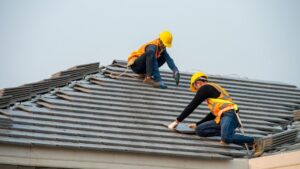A new roof is one of the best investments you can make for your home. Studies show that a new roof can increase resale value by up to 80%.
However, roofing replacement costs can vary greatly. Some factors include geographic location, labor rates, and material prices. Choosing the right roofing materials is also important to minimize future expenses. Visit our Website to learn more.

Asphalt shingles are the most common roofing material for new construction and home renovations. They protect your home from rain and other weather elements, keeping you and your family dry and comfortable.
There are different types of asphalt shingles, each with their own benefits and drawbacks. The most basic type is the three-tab shingle, also called architectural shingles. It’s a single layer with cut-outs that form three individual tabs. Its low price and wide availability make it a popular choice. Other shingles, sometimes called premium shingles, are designed to mimic the appearance of other roofing materials like shakes and slate tiles. Some are even crafted to offer improved performance characteristics such as impact resistance or solar reflectivity.
The standard asphalt shingle is made of either an organic or fiberglass mat saturated and coated with asphalt then topped with ceramic-coated opaque mineral granules. The granules help protect the shingle from the sun’s damaging UV rays and give the shingle color. Some shingles are manufactured with special features such as built-in gutter guards to help prevent debris from building up in your roof. There are also specialized shingles to cover hips and ridges of your roof, as well as underlayment sheets that provide additional protection from moisture.
The biggest drawback to asphalt shingles is their limited lifespan. They can become brittle and vulnerable to damage from extreme weather conditions if not properly maintained. The most important maintenance step is keeping your roof clear of debris such as leaves, branches, and other waste. A clean roof is also more attractive and safer. In addition, preventing thermal shock by maintaining a consistent temperature in your attic with proper ventilation (balancing intake and exhaust) can extend the lifespan of your asphalt shingles.
Cedar shakes offer an eye-catching look and can add value to your home. They are also highly insulating, which can help lower your energy bills. However, they require regular maintenance. For example, moss and mildew can eat away at the shakes, leaving them vulnerable to rot. The best way to prevent this is to regularly clean your cedar roof.
In addition, it’s important to select a contractor who is experienced with installing cedar shakes. The right contractor will provide you with a workmanship warranty and have the knowledge and skills necessary to install your roof correctly.
A newer alternative to hand-split cedar shakes is the synthetic option called CeDUR. These shakes are molded from real cedar and made of state-of-the-art polyurethane material, making them almost indistinguishable from the real thing. These shakes are moisture-resistant, making them much more durable than traditional natural wood.
When it comes to installation, it’s important to follow the grading standards set forth by the Cedar Shake and Shingle Bureau (CSSB). These guidelines include a mix of shake widths in each bundle, as well as a ventilation matrix. These requirements help ensure the correct overlaps and an aesthetically pleasing layout on your roof.
Uplift resistance is another factor to consider when choosing a roofing material. The CSSB tests shakes and shingles against wind-induced uplift to determine the strength of the material. The results show that shakes and shingles are up to 90 psf stronger than OSB.
The uplift resistance of shakes and shingles is a direct result of the number of watershedding layers working together to keep rain out of your home. This means that it is critical to keep your gutters and roof free from debris that can impede water flow. Overhanging tree limbs are a common culprit because they can block air flow and allow water to sit on the shakes. This moisture can lead to rot and mold, which will ultimately shorten the shakes’ lifespan and damage your home.
There are a number of different manufacturers of synthetic cedar shakes that offer superior options to natural cedar. These shingles are typically made from resins and polymers that mimic the appearance of cedar but can withstand severe weather far better than traditional wood. They can also withstand moisture and won’t need constant maintenance. These shingles are available in an array of colors and styles, making it possible to create a look that will add to your home’s curb appeal. If you live in a community with an HOA, it’s important to check if there are any restrictions on shingle color or style.
Cedar is prone to insect infestations that can cause damage and need to be removed regularly. Additionally, the material can be susceptible to rot and mildew. In addition, it’s more prone to fire damage than an asphalt shingle and presents a serious risk for property owners in areas prone to wildfires. Thankfully, a few high-end manufacturers have created options that will not only look amazing, but will also provide peace of mind and allow you to comply with your homeowners insurance requirements.
The synthetic cedar shakes have a Class A fire rating and class 4 impact ratings. They also help to reduce energy costs by offering a higher R-Value than standard shingles. You can use them in conjunction with standing seam metal or copper roof accents to really bring your house’s aesthetic to life and improve its value.
Slate roofing dates back centuries and is one of the highest-quality materials available today. This material can add an authentic and classic look to more traditional homes, with a lifespan of up to 150 or 200 years, outlasting multiple generations. However, it is also one of the heaviest materials on the market and can be quite costly. For this reason, some homeowners opt for a synthetic slate option that offers the same appearance at a more affordable price.
The benefits of a slate roof are many, including fireproof qualities and a long lifespan. These roofs are also extremely durable and resistant to mildew and mold. In addition, these roofs are incredibly attractive and can add value to your home. But it’s important to remember that a slate roof isn’t the right choice for every property, as it can be expensive and requires an expert installation.
One of the most common problems with a slate roof is damage from hail. This damage often leaves a hole in the roof and can lead to additional issues with your home, such as leaking or water damage. It is crucial to inspect your slate roof regularly and call in a professional to repair damage immediately.
Because of its longevity, it is difficult to determine if your slate roof needs replacement. If you’re unsure, contact a local roofer with experience in handling this material to evaluate your roof and recommend the best solution for you. It is also important to recognize when it’s time to call in the professionals, such as extensive damage or widespread leaks. Trying to DIY these issues could lead to more extensive and costly repairs in the future.
If you’re looking for a roofing material that will last for a lifetime and add a major boost to your curb appeal, clay tiles are an option worth considering. Though they may seem expensive due to their weight and the fact that they aren’t easy to install, they will outlast asphalt shingles and are considered an eco-friendly alternative. Clay roofs are highly resistant to heat and allow air to circulate which helps to keep your home cool in the summer. They are also fire-resistant and can withstand high-speed winds.
Unlike other roofing materials that can become damaged by mold and algae, clay tile is naturally impermeable. This makes it an excellent choice for coastal areas that are exposed to salt air and extreme temperature fluctuations. They are also color-fast and will not change in appearance due to exposure to the elements.
Clay tiles are durable and resistant to moisture absorption and are a good option for homeowners in regions that experience frequent hailstorms. They are also highly resistant to fire, wind and earthquakes. Because of their density and insulating properties, clay tiles are energy efficient and can help to lower your home’s utility bills. Many clay tile roofs are ENERGY STAR rated and can reduce your energy costs by up to 20%.
The natural beauty of terra cotta clay tiles is complemented by the range of styles and colors available to match any aesthetic or architectural design. They are also a great choice for homes that require an airy, spacious feel. They are easy to clean and will not rot or attract insects. If you want a more rustic look, you can opt for clay tiles with a rough surface that gives the impression of a weathered barn or cottage.

